Masonic regalia is vital to Freemasonry, symbolizing tradition, symbolism, and identity. Aprons to jewels of office, every item of Masonic regalia has a profound symbolic meaning binding members together across generations. This article presents an in-depth blog post structure: Masonic regalia, spanning its history, types, craftsmanship, symbolism,
And cultural significance. You will see how regalia evolved, what it is applied to within various Masonic degrees, and why it’s still one of the most iconic aspects of Masonic tradition. Knowing these things helps unlock the deeper significance of regalia in forming the brotherhood.
Historical Origins of Masonic Regalia
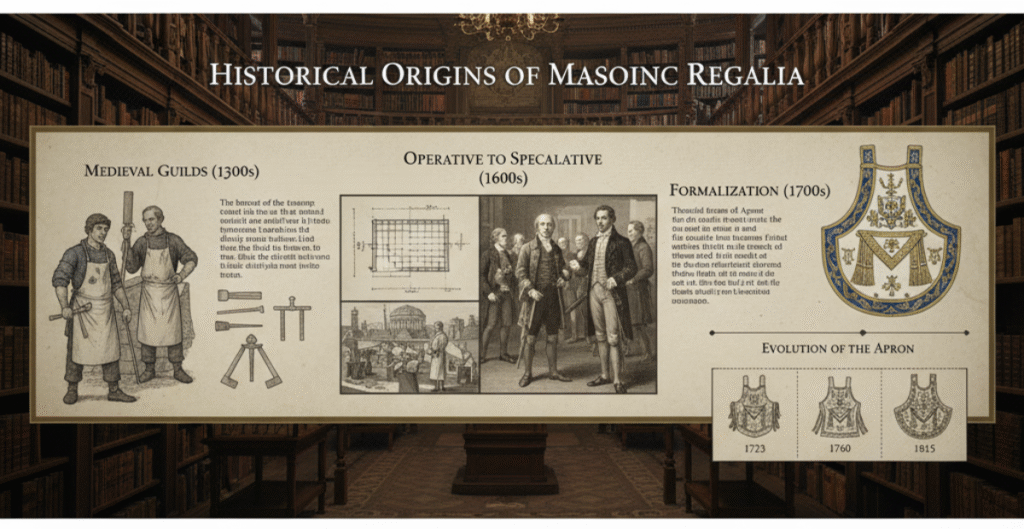
The story of Masonic regalia begins in the time of operative stonemasons. These early masons wore aprons, gloves, and working tools as part of their daily labor. Over time, when Freemasonry shifted into a speculative order during the seventeenth and eighteenth centuries, these practical garments became ceremonial symbols. They were no longer just for protection at work but represented honor, virtue, and fraternity.
Medieval guilds also influenced the design and meaning of regalia. Many symbols, such as the square and compass, came from tools used in stonework. As lodges spread across Europe and later to America, styles of regalia adapted. What began as plain aprons turned into decorated pieces with embroidery, colors, and precious materials, reflecting the values of the lodge and the status of the wearer.
Types of Masonic Regalia
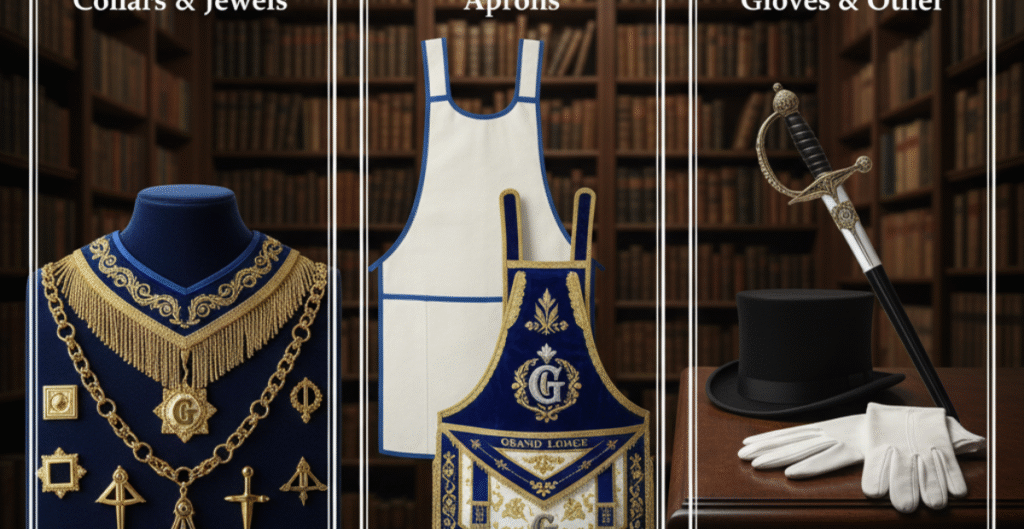
Masonic regalia comes in many forms, each with its own purpose. The most recognized is the apron, which varies in design depending on degree. Entered Apprentices wear simple white lambskin aprons, while Master Masons often wear decorated versions with blue or gold trim. Along with aprons, members also use collars, jewels of office, gloves, and sashes.
Headwear is another part of Masonic regalia that changes depending on the order. For example, Knights Templar wear distinctive caps and mantles, while Shriners are known for their red fezzes. In addition, some items like lodge furniture and ceremonial swords are also regarded as regalia, since they hold symbolic meaning during rituals.
See more: Red Fez Shrine Club: History, Symbolism, and Legacy
Common Types of Masonic Regalia
| Regalia Item | Description | Usage |
| Apron | White or decorated lambskin | Worn by all members by degree |
| Collar & Jewel | Embroidered collar with medal | Worn by officers |
| Gloves | White gloves | Symbol of purity |
| Headwear | Fez, cap, or hat | Used in different orders |
| Sash & Gauntlets | Colorful fabric and cuffs | Higher degrees |
Symbolism and Meaning
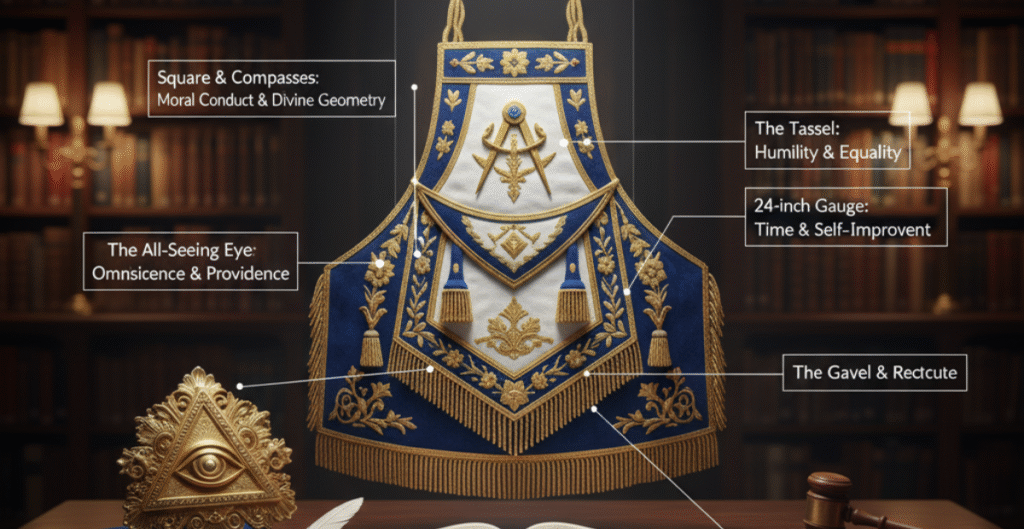
The symbolism within Masonic regalia is rich and layered. Each item carries a message, reminding members of their moral duties and values. For example, the apron represents innocence and purity of life. The gloves symbolize clean hands and honorable actions. The jewels of office, shaped like squares, compasses, and levels, represent fairness, morality, and equality among men.
Colors also play an important role. Blue is linked with friendship and truth, red with courage and zeal, while white represents purity. By wearing regalia, Masons are reminded not just of their duties in the lodge but also of how they should live their daily lives.
Regalia by Masonic Degree and Order
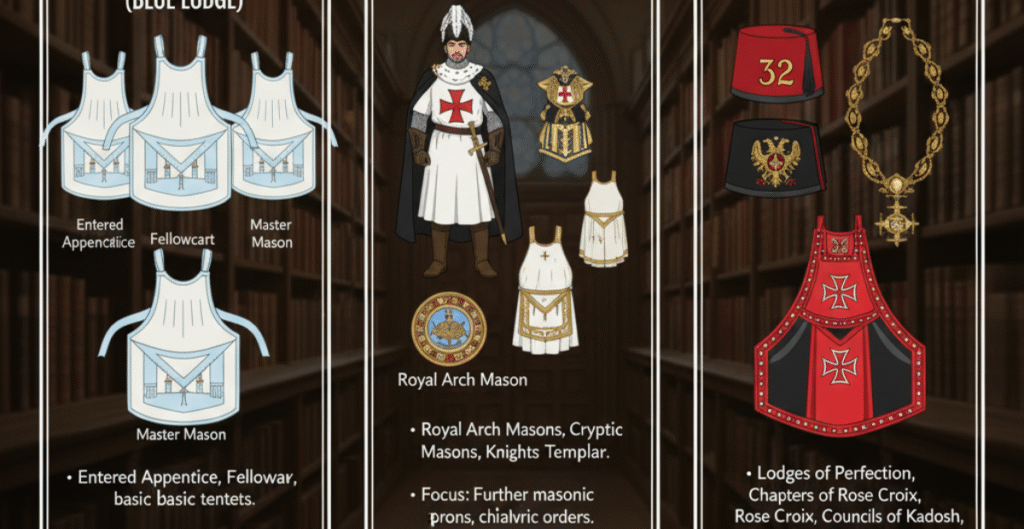
Each degree in Freemasonry has its own unique regalia. In the Craft Lodge, which includes the Entered Apprentice, Fellow Craft, and Master Mason, regalia is simple but symbolic. The higher degrees, such as the Royal Arch or the Knights Templar, involve more ornate designs, often using velvet, embroidery, and metallic thread.
Other orders, such as the Scottish Rite, also have their own distinct regalia. This variety shows the diversity of Masonic bodies while keeping a shared connection through symbols and colors. No matter the degree, each piece of regalia carries the same purpose: to remind members of their moral and spiritual journey.
Craftsmanship and Materials
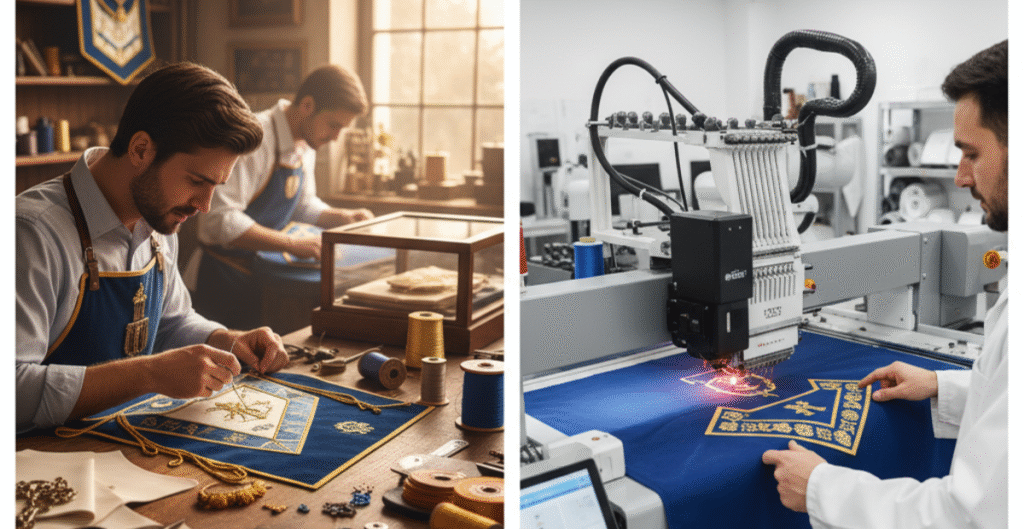
The making of Masonic regalia reflects centuries of tradition. Early aprons were crafted from pure lambskin, representing purity and innocence. Fine silk and hand embroidery were used for sashes and collars. Jewel pieces were often made of silver or gold, crafted by skilled artisans. These items were meant to last a lifetime and often became family heirlooms.
Today, while many regalia items are mass-produced with synthetic fabrics and machine stitching, there is still demand for handcrafted regalia. Skilled craftsmen continue to produce intricate designs using traditional methods. Regional differences also shape the style of regalia. English regalia, for example, tends to follow stricter traditional designs, while American versions allow for more creativity.
Rules, Etiquette, and Wearing of Regalia
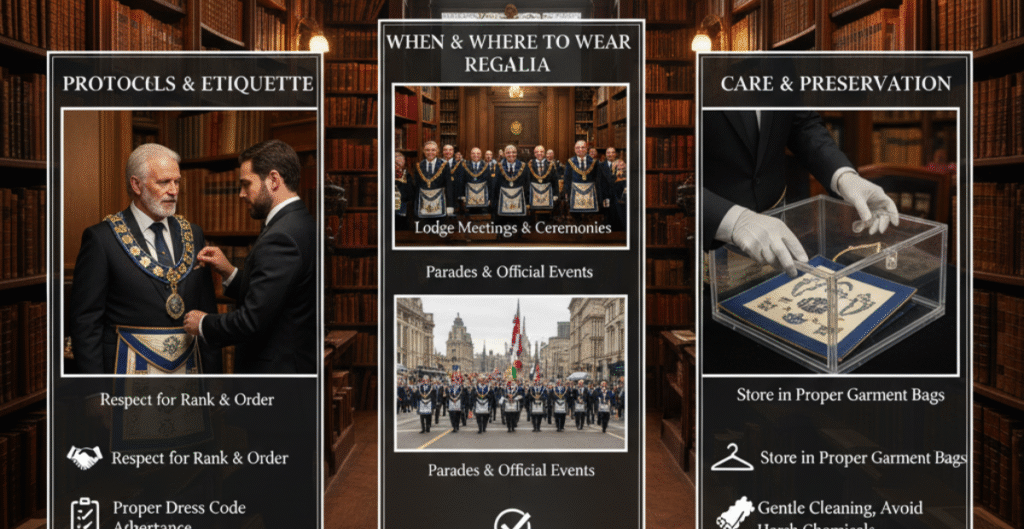
Freemasonry has strict rules about who can wear certain regalia. Members must only wear the regalia of their degree or office, and it should always be worn with respect. For example, a Master Mason cannot wear the apron of a Past Master unless he has earned that title. Regalia is also used in ceremonies, meetings, and processions, where proper etiquette must be observed.
Etiquette also extends to how regalia is presented. It should be clean, well-maintained, and treated as a sign of honor. Wearing regalia in public outside Masonic events is rare and usually limited to funerals or parades. This sense of order ensures regalia retains its dignity and meaning.
Care, Preservation, and Storage
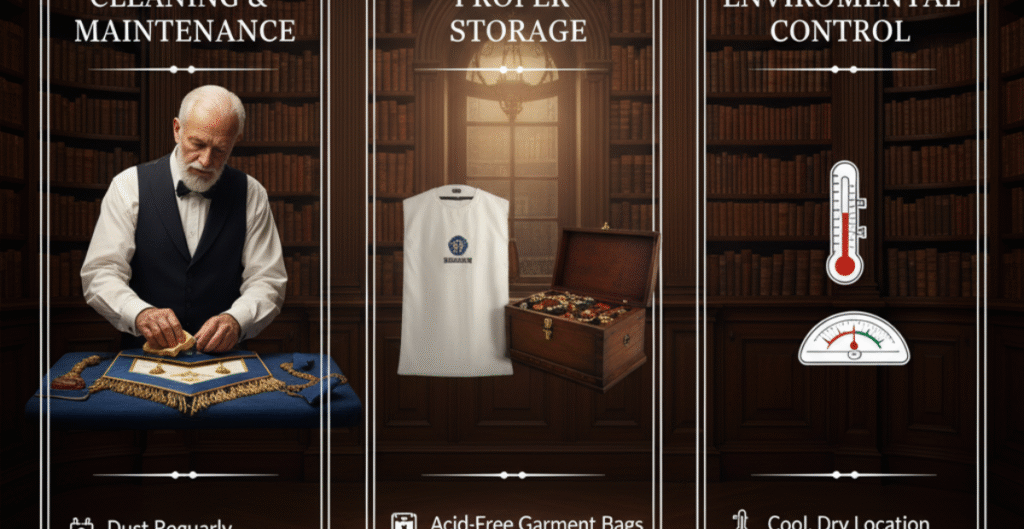
Taking care of Masonic regalia is important for preserving its beauty and meaning. Aprons and sashes should be kept in protective cases, away from moisture and sunlight. Gentle cleaning is necessary depending on the fabric, while metallic threads or embroidered jewels require special handling.
Antique regalia often needs restoration. Many lodges have passed down regalia for generations, and preserving these items maintains a link to the past. Professional restorers can repair embroidery, replace faded ribbons, and clean delicate fabrics. Proper care ensures regalia lasts long enough to be passed to future Masons.
Care Tips for Masonic Regalia
| Regalia Type | Cleaning Method | Storage Advice |
| Aprons | Spot clean with mild soap | Store flat in case |
| Gloves | Hand wash gently | Keep in dry area |
| Collars & Sashes | Dry clean only | Hang in garment bag |
| Jewels & Medals | Polish with care | Wrap in cloth |
| Antique Pieces | Professional restoration | Climate-controlled storage |
Collecting and Cultural Value
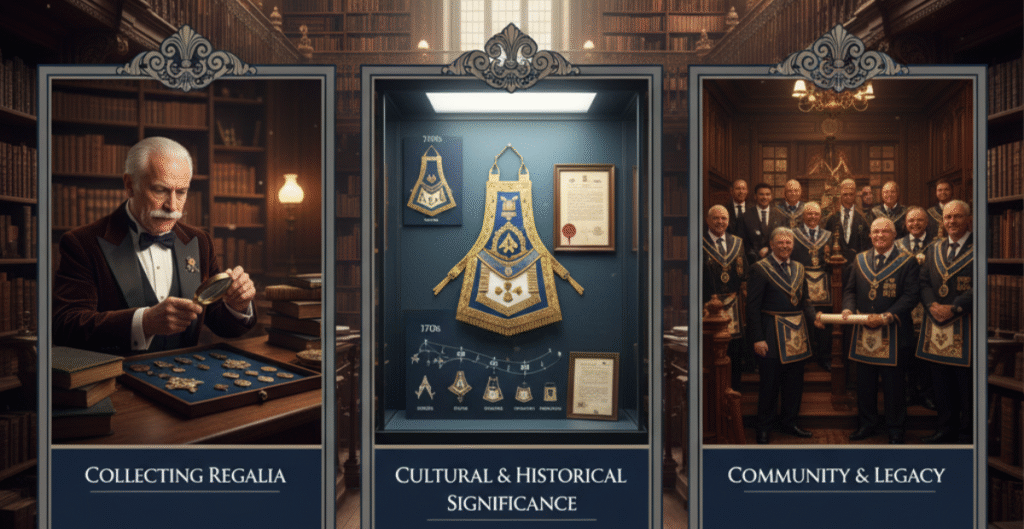
Many families view Masonic regalia as heirlooms, passing aprons, sashes, and jewels from one generation to another. This gives regalia a personal value that goes beyond material worth. For collectors, antique regalia can also have significant market value. Rare aprons, historic jewels, and early hand-embroidered items are sought after in auctions and private sales.
Museums also hold collections of Masonic regalia, helping the public understand Freemasonry’s role in cultural history. However, regalia is sometimes misunderstood by outsiders who may not know the symbols. Despite this, its cultural importance remains strong, as it reflects centuries of tradition, artistry, and fraternity.
You will like : Freemason Accessories: A Complete Guide to Regalia, Jewelry, and Ceremonial Items
Collectible Value of Masonic Regalia
| Type of Regalia | Collectible Value | Example |
| Antique Aprons | High | 18th-century lambskin aprons |
| Jewels & Medals | Medium to High | Silver officer jewels |
| Headwear | Medium | Fezzes, Knights Templar caps |
| Sashes & Collars | Medium | Hand-embroidered silk pieces |
| Lodge Furniture | Variable | Gavel, sword, chairs |
Influence of Regional Traditions
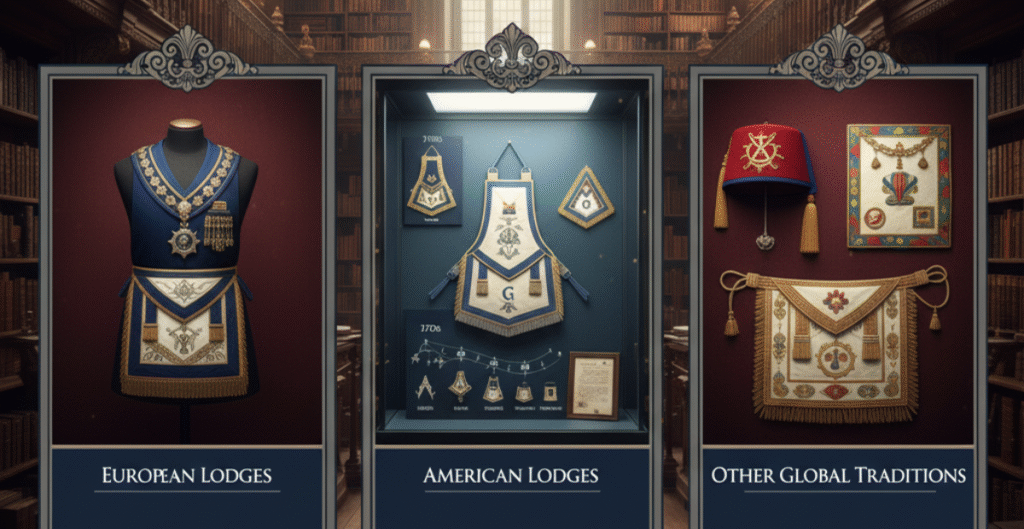
Masonic regalia is not the same in every country. While the symbolism remains constant, regional traditions shape its style and presentation. In England, aprons and collars follow strict traditional designs, often using blue and gold. In Scotland, regalia includes tartan patterns and different embroidery styles. American lodges allow more creativity, with designs varying from state to state.
This regional diversity shows how Freemasonry adapts to local culture while keeping its shared values. A Mason from France may wear regalia with ornate embroidery, while a Mason in Canada might use simpler designs. Despite differences, all regalia connects back to the same roots of symbolism and brotherhood.
Famous Examples of Masonic Regalia
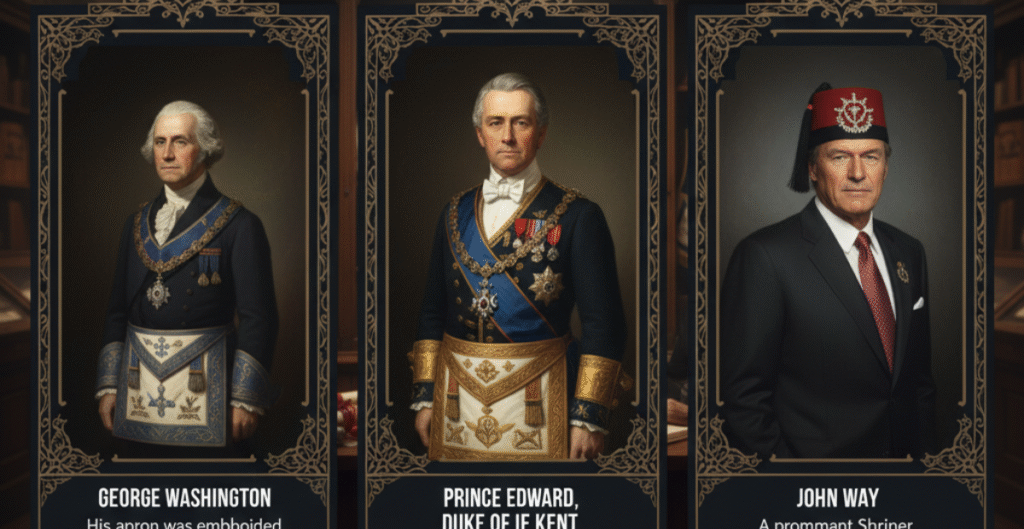
There are many historic pieces of Masonic regalia linked with famous figures. George Washington, one of the most well-known Freemasons, wore a simple lambskin apron during the cornerstone ceremony of the U.S. Capitol. That apron is preserved today as a national treasure. Other historic regalia includes ornate jewels and collars worn by European kings who were members of the Craft.
These examples show how regalia is tied not just to Freemasonry but also to world history. Museums often display such items to highlight the influence of Masonry in culture and politics. Seeing these pieces reminds modern Masons of the legacy they share with leaders of the past.
FAQ”s
What is the purpose of Masonic regalia?
It represents tradition, morality, and rank within Freemasonry, used in ceremonies and rituals.
Why are aprons important in Masonic regalia?
Aprons symbolize innocence and the honor of Freemasonry, tracing back to operative stonemasons.
Can non-Masons wear Masonic regalia?
No, regalia is restricted to initiated members and is worn according to degree or office.
How should Masonic regalia be stored?
It should be stored in protective cases, kept clean, and preserved in a dry environment.
Is Masonic regalia valuable to collectors?
Yes, antique regalia holds significant cultural and financial value, especially older handcrafted pieces.
Conclusion
Masonic regalia is more than clothing. It is a link to history, a symbol of values, and a mark of identity. From aprons and jewels to sashes and gloves, each piece carries a meaning that connects members across generations. With proper care and respect, regalia continues to inspire, teach, and unite Freemasons worldwide. This blog post outline: Masonic regalia shows how tradition, craftsmanship, and symbolism remain alive through the regalia that defines the fraternity.




